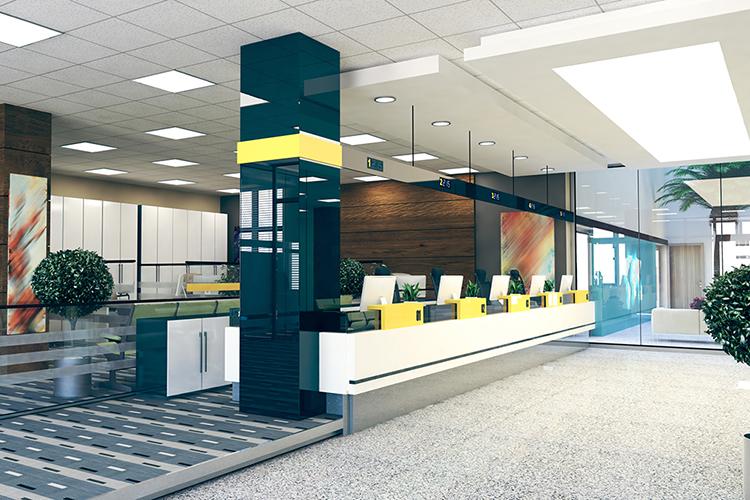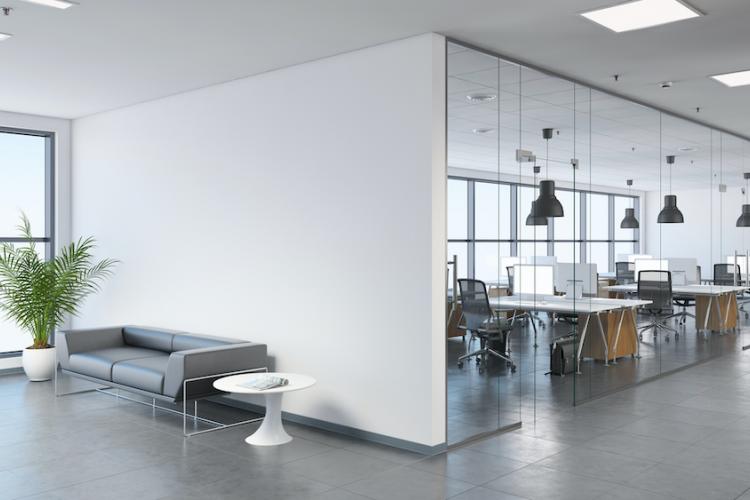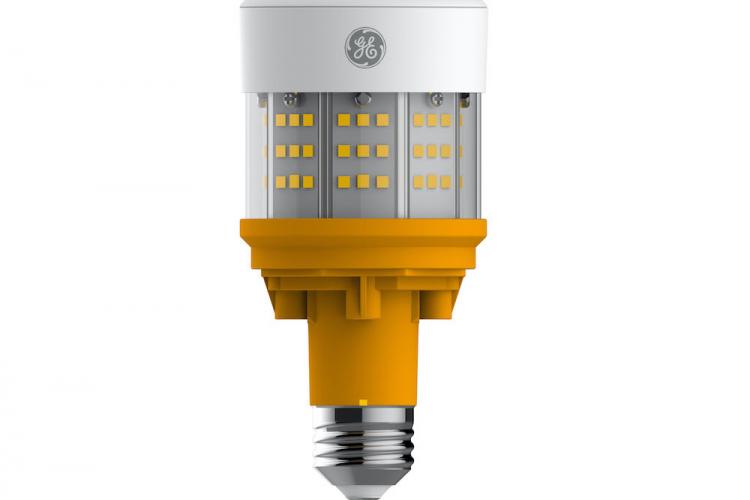Strategies for a Smarter, More Efficient Bank Branch
Strategies for a Smarter, More Efficient Bank Branch
For financial leaders looking to reduce operating costs and meet sustainability objectives, transforming a branch or office space into a smart building is a driving force to achieving those goals. But more than that, switching to a smart building can also create a seamless and more satisfying customer experience as well, aligning to their expectations and bringing in more revenue-generating traffic.
Building the Intelligent Environment
The smart building’s evolution is top of mind for financial leaders, who continuously focus on reducing operating costs, meeting sustainability objectives, optimizing space within their real estate portfolio and improving their customers’ experiences within a branch. While over the past decade, much attention has been focused on energy savings and achieving sustainability goals, today there is tremendous attention being paid toward improving the customer experience, increasing safety and security, and monitoring assets for more efficient operations. In our view, lighting has the ability to serve financial institutions in achieving economic and efficiency goals.
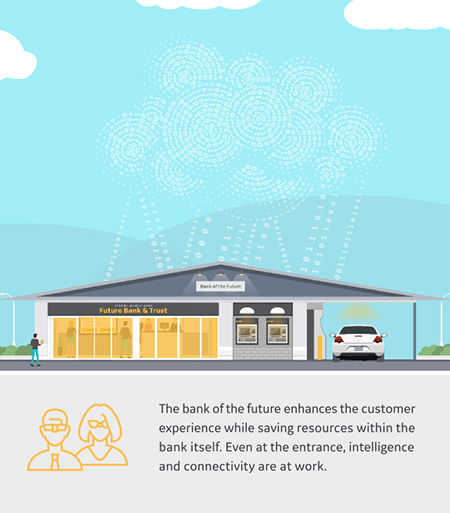 To enable the retail bank branch of the future, organizations have begun to implement an entirely new environment: the digital workplace. By integrating the technologies that employees and customers use with a sensor-enabled environment, banks can reduce energy usage, identify and remediate maintenance issues, strengthen the relationship with their customers and create a more welcoming environment.
To enable the retail bank branch of the future, organizations have begun to implement an entirely new environment: the digital workplace. By integrating the technologies that employees and customers use with a sensor-enabled environment, banks can reduce energy usage, identify and remediate maintenance issues, strengthen the relationship with their customers and create a more welcoming environment.
In one particular perspective of value proposition for smart buildings, the facilities management company JLL provides a “3-30-300” model as a basis of value for quantifying potential benefits. Within their model, potential savings guidelines are presented as follows: $3 per square foot for energy savings, $30 per square foot for space utilization/ optimization savings, and $300 per square foot pertaining to improving employee effectiveness. Although each category of savings is important, the potential benefit of $300 per square foot gives credence to the focus of improving employee effectiveness in the workplace.
JLL further explains in the report, Health, Wellbeing and Productivity in Offices: The Next Chapter for Green Building: “After all, staff costs, including salaries and benefits, typically account for about 90 percent of business operating costs. Therefore, what may appear a modest improvement in employee health or productivity can have a huge financial implication for employers—one that is many times larger than any other financial savings associated with an efficiently designed and operated building.”

Technology continues to evolve and positively impacts each of the categories of focus for smart building initiatives among global real estate leaders. Such technology is rooted in highly advanced digital sensors that provide continuous information in real time for all aspects of smart building decision-making and overall operation.
These highly intelligent digital sensors operate together in an advanced network to further expand opportunities for savings in energy, make a positive impact toward sustainability goals and optimize space planning and asset monitoring.
Existing Conditions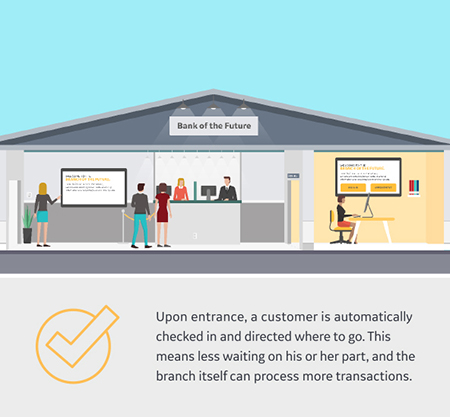
There are approximately 90,000 bank branches nationwide, and each one faces stiff competition for customers, pressure from corporate offices, increasing compliance requirements and other operational challenges. While priorities may vary, all are looking for ways to save money and operate more efficiently without negatively impacting the customer experience. Over the last several years, many banks have taken steps to address energy efficiency through selective LED retrofits, as well as addressing ATM compliance requirements. However, we understand that the existing technology and resources are not meeting the needs of organizations with respect to proactively managing the portfolio (e.g., manage alerts, alarms and global scheduling).
There’s a strong commitment to sustainable practices across the banking industry, and we’re seeing the efficient operation of branches take on even more importance. Branches alone can account for 60 percent of a bank’s total energy use before adding ATMs, offices and other sites. Within these buildings, HVAC can represent 40 percent to 50 percent of the total energy consumption, followed by lighting at 20 percent to 30 percent and electronic equipment around 10 percent to 20 percent, according to the Energy Information Administration (EIA). Saving starts with installing more-efficient products such as LED lighting, high-performing Remote Terminal Units (RTUs) or plug load controls, but that’s just part of the answer. With millions of square feet of commercial offices and branches spread out across the globe, energy and real estate management are a challenge. In the past, there was no practical way to support perceptions about space utilization in each branch with hard data.
Branches can account for 60 percent of a bank’s total energy use before adding ATMs, offices and other sites.
Current, can develop a comprehensive solution that allows you to have visibility to the entire retail and commercial portfolio, in addition to providing massive energy savings. LED lighting alone can save organizations 50 percent or more energy compared to traditional lighting methods. The value grows exponentially when sensors and controls are integrated into the new digital ceiling. These controls provide tools such as daylight harvesting, occupancy sensors and dimming that can save up to 30 percent more energy. But the real value stems from the enterprisewide view of branch operations provided by Current’s AllSites™ platform. This software acts as a way to monitor HVAC systems, physical access, space utilization, ATM compliance and more across thousands of branches through one system. That makes it much easier for banks to leverage proactive maintenance and spatial changes that enhance the experience at branches and create a more secure environment for customers and employees alike.
LED lighting alone can save organizations 50 percent or more energy compared to traditional lighting methods. Controls providing tools such as daylight harvesting, occupancy sensors and dimming can save up to 30 percent more energy.
Current has developed a value proposition for retail banks to highlight the savings and payback of LED lighting and controls, and the benefits they provide. The model uses information such as square footage, average energy cost by location, and product and installation costs to determine the investment, annual benefits and return on investment. For bank branches, Current developed a model based on energy usage figures provided, branch information, the average utility rate by state and our experience with similar customers.
This value proposition model can be applied to your entire branch portfolio to find the monetary value of these services. As an example, let’s consider the value of adding LED retrofits across 100 sites in the U.S. This change can account for over $450,000 in savings per year, leading to a solution payback in three years. Lighting solutions are enhanced by controls, which assist in asset management, HVAC monitoring, security and more. The additional energy reduction and maintenance savings made possible by these controls provide an additional annual benefit of $175,000. Return on investment would be achieved in about three years.
Adding LED retrofits across 100 sites can account for over $450,000 in savings per year, leading to a solution payback in three years.
Activating AllSites across the portfolio allows for a bird’s-eye view of all branches. This will enable better real estate decisions, smarter scheduling, improved sustainability efforts and increased security—in addition to the energy and maintenance savings. Per our model, AllSites can provide $220,000 in benefits, bringing the total to $850,000 annually.

Based on Current’s value proposition and the information provided, the estimated payback for LED lighting and controls and AllSites is 2.2 years. Perhaps most notably, the cost of waiting to install LED lighting and a building automation system is more than $71,000 per month. (Note that because individual sites have not been audited, all figures are based on similar clients and were calculated based on Current’s assumptions. The final numbers will change.)
Energy Savings and Sustainability
There’s a strong commitment to sustainable practices across the banking industry, and we’re seeing the efficient operation of branches take on even more importance. The return on investment for transitioning to LED lighting is massive: If 100 sites make the switch to LED lighting with controls, the estimated savings is over $600,000 per year.
If 100 sites make the switch to LED lighting with controls, the estimated savings is over $600,000 per year.
LED lighting saves 50 percent or more over the energy required for traditional lighting technology. But what many banks want is greater visibility into the health of their assets and greater control of building systems 24/7. When lights in an empty room can switch off automatically or when your air conditioner isn’t running needlessly, that’s where the biggest reductions are waiting to be realized. Smart sensors that assist with daylight harvesting, task tuning and dimming for even more refined quality of lighting in the bank branch can save an additional 20 percent to 30 percent in lighting energy.
 Pertaining to environmental improvements in the modern retail branch, sensor technology advancements now enable even more comprehensive, real-time data. Consider the traditional HVAC system in a building. The customary solution for monitoring HVAC is manual. Someone must be tasked with this job at each individual bank branch, with little to no visibility at the enterprise level. But what once relied on a limited number of wired thermostats, placed in a building at the time of construction to provide temperature readings to the HVAC system, has given way to the flexibility of the facility easily responding to change thanks to Current’s automated AllSites solution. In the new paradigm, easily deployed wireless sensors and wireless thermostats can be placed and adjusted throughout the building to provide much more granular controls, comfort and associated energy savings.
Pertaining to environmental improvements in the modern retail branch, sensor technology advancements now enable even more comprehensive, real-time data. Consider the traditional HVAC system in a building. The customary solution for monitoring HVAC is manual. Someone must be tasked with this job at each individual bank branch, with little to no visibility at the enterprise level. But what once relied on a limited number of wired thermostats, placed in a building at the time of construction to provide temperature readings to the HVAC system, has given way to the flexibility of the facility easily responding to change thanks to Current’s automated AllSites solution. In the new paradigm, easily deployed wireless sensors and wireless thermostats can be placed and adjusted throughout the building to provide much more granular controls, comfort and associated energy savings.
Let’s say you want to prioritize the maintenance of retail branches. Most banks use a national or global workflow management system to coordinate maintenance and repairs, whether it’s to address an RTU that’s making loud noises or lights that have gone out. Typically, someone will go into the system and create a notification that’s put in a queue. It might be a facilities team or outside contractor that handles the job from there. But with a better understanding of exactly how old an asset is, its repair history and how well that piece of equipment is performing today, it becomes easier to identify what constitutes a priority mission and what doesn’t. Now you’re not paying a higher labor rate for work you know can wait. On the contrary, you can immediately dispatch a crew to locations where the customer experience might be affected. With a wider view, you can also see which sites are most successful and apply best practices to other properties. Sophisticated controls and cloud-based technologies are making it possible for fewer people to manage more sites more simply and effectively.
Our Experience
Several brands are already reducing energy usage and improving efficiency with Current’s help. More than 600 Morgan Stanley wealth management branches are installing LED lighting and digital controls to cut energy consumption by 50 percent. The rollout is also expected to boost productivity and elevate the customer experience. Another major bank in the Mid-Atlantic and Southeast U.S. is retrofitting thousands of branches with Current. More than 1,500 branches have been updated and outfitted with AllSites, and that number is expected to reach 4,000 by the end of 2018. JPMorgan Chase & Co. is upgrading nearly 4,500 branches across the U.S. through a partnership with Current. New LED lighting and controls will decrease lighting-related energy usage by about 50 percent. JPMC will leverage our AllSites application to gain an enterprise-level, cloud-based view into energy and HVAC efficiency across its retail branches. The bank will also use an app built by Weathermatic to manage water usage. That pairs perfectly with Current’s platform, which manages HVAC, lighting and leak detection as part of its energy management.

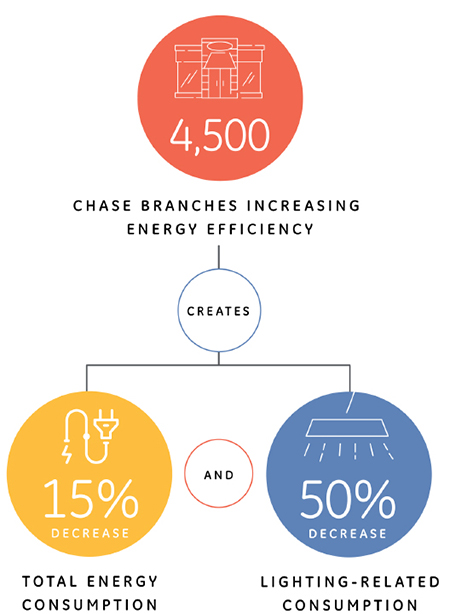 Energy and asset management are gateways to data collection that can impact not just operational efficiency, but also the customer experience. Current uses ZigBee standards to allow seamless interoperability between many different types of IoT devices, regardless of their vendor or vintage. That these devices can now speak a universal language means banks have more access to products and services going forward, including connected lighting, HVAC and other smart building solutions. All companies have an array of disparate systems and equipment to manage, and placing a wireless network on top of this infrastructure is a big step in taking site-level control of your property portfolio. At the same time, it’s an entrance into enterprisewide visibility that all organizations value immensely.
Energy and asset management are gateways to data collection that can impact not just operational efficiency, but also the customer experience. Current uses ZigBee standards to allow seamless interoperability between many different types of IoT devices, regardless of their vendor or vintage. That these devices can now speak a universal language means banks have more access to products and services going forward, including connected lighting, HVAC and other smart building solutions. All companies have an array of disparate systems and equipment to manage, and placing a wireless network on top of this infrastructure is a big step in taking site-level control of your property portfolio. At the same time, it’s an entrance into enterprisewide visibility that all organizations value immensely.
In today’s digital landscape, information security is paramount. Current takes many steps to ensure that its intelligent environment solution is secure. First, all edge devices undergo rigorous review by security teams, which conduct regular network and cloud security assessments, perform vulnerability tests and implement product cybersecurity best practices. In addition, all software undergoes regular application security testing as part of Current’s software development life cycle. With the solution data hosted on Amazon Web Services and secured via the HTTPS protocol, customers can feel confident that their data is safe, secure and available only to registered users. Current also suggests customers consider deploying an air-gapped network for their intelligent environment solution. An air-gapped network physically separates IoT traffic from the IT traffic, effectively eliminating the possibility of devices from one network communicating with devices on the other.
Smarter Bank Branches Enable Smarter Business Decisions
The rise of mobile banking technologies has made physical locations less central to the customer experience, prompting some branches to shrink their spaces. Consider a report by commercial real estate firm JLL that found the U.S. banking industry could save $8.3 billion a year by downsizing the average branch from 5,000 to 3,000 square feet. As banks reduce their physical footprint to cut costs, reducing their energy footprint falls right in line with that. Branches aren’t going away but are increasingly at the center of operational improvement strategies.
The U.S. banking industry could save $8.3 billion a year by downsizing the average branch from 5,000 to 3,000 square feet.
Continuous improvement is at the core of Current’s future-proofed technology. With our open system and expansive network of partners, bank branches will have the opportunity to add tools and applications that further business aims and optimize operations in the years to come. For example, our solution includes occupancy sensors that provide valuable real estate data, such as what space is being occupied the most or the least in your facilities. The insights provided by our solution will allow for tough real estate decisions to be made with research to back them. This information could allow a design and construction team to know what adjustments should be made when implementing a renovation strategy or even provide insight into new construction sites. This is how banks like JPMC are able to shrink the size of their branches without sacrificing the customer experience or journey. By including people-counting sensors and data, you would also be given information on the foot traffic coming to your sites, the number of cars that come through the drive-through or even ATM/kiosk usage. That data may be key to help with employee scheduling, so during peak and down times you have the right assistance for your clients while efficiently managing staff.
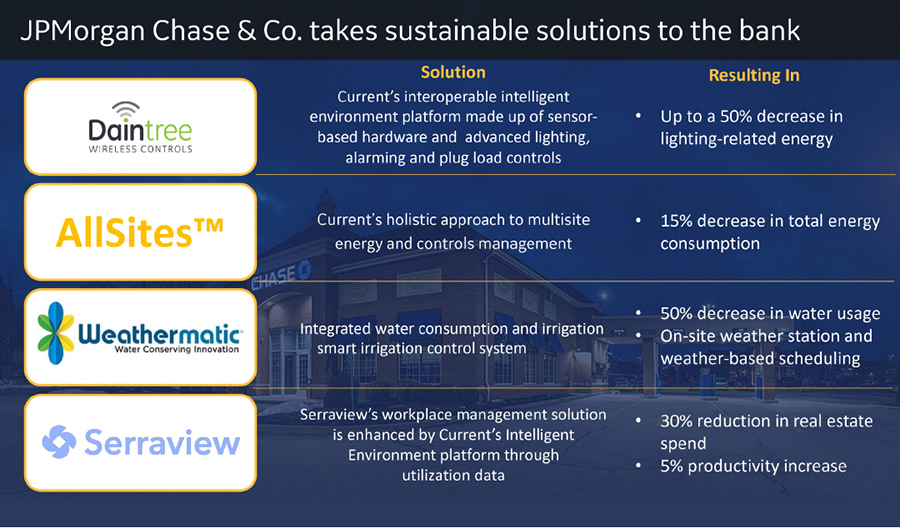
Leading financial institutions are not happy with status quo. They are continuously evaluating the branch of the future to provide the best environment for their customers. It is not enough for them to implement LED lighting for energy savings. They want to provide the best quality of light possible for an optimum banking environment. Retail bank branches are extending beyond simply providing a set color temperature and lumens for the workplace.
High-quality lighting with the flexibility for adjustable color temperature and intensity of light provided, not only has the power to enhance architecture, elevate aesthetics and improve the energy efficiency of a space, but also increases safety and security. For example, Current is working with Capital One to enhance the customer experience at ATMs should a light go out after hours. Adding indoor and outdoor circuit-based lighting automation with failure detection and enterprise-level alarms means banks will be alerted automatically should a light go out near an ATM, allowing them to deploy maintenance teams as soon as possible and keep up with compliance measures.
High-quality lighting with flexibility in color temperature can enhance architecture, elevate aesthetics, improve the energy efficiency of a space, and increase safety and security.
With the right controls, you can “see” your operation differently. For instance, among banks there’s great interest in counting the number of people coming into the branch. This data could trigger a text message to all employees, alerting them anytime additional customer service is required. And over time, this same data can reveal trends, including when the biggest crowds come into the bank. When you can capture foot traffic at that granular level, it starts to inform things like smarter scheduling, such as putting more employees in the branch during peak transaction times or shifting service activities to sales activities when things slow down. Also, the sensors and intelligent devices in your branch can be used to engage customers by sending reminders and special offers to their smartphones, or maybe a map showing which office to go to. Many banks that start on this path with energy savings as the main goal will also learn how to leverage these same technologies to create experiences customers come back for.
The success of a digital ceiling in retail branches may lead to the expansion of the solution into office environments as well. In your commercial office spaces, a solution with occupancy sensors and people-counting data can allow for better space optimization and utilization, more informed real estate decisions and increased employee productivity and retention. The real-time occupancy data provided by such sensors provides tremendous input to business productivity applications such as integrated workplace management software. One such application, Serraview, is in use at JPMorgan Chase for commercial office space management. With the active use of such applications, day-to-day tasks such as scheduling an open conference room, finding an open office area or reserving a particular unoccupied “hoteling space” to use can easily be accomplished. To give credence to the magnitude of such benefits, let’s take a look at the value proposition for more efficient meeting room management. Consider a simple dataset of 10,000 employees, who each waste five minutes a day scheduling, looking for or waiting for a conference room. With the real-time data we collect and provide to an application partner, that application can take that five minutes of wasted time and reduce it to one. The time savings of four minutes per day per employee is about 200,000 hours per year. And if you apply an average hourly wage of $50 per hour, this is $10 million annually of potential productivity gains!
A solution with occupancy sensors and people-counting data in commercial office spaces can allow for better space optimization and utilization, more informed real estate decisions, and increased employee productivity and retention.
Current’s Solution Summary
Current’s Daintree† Enterprise is the market’s leading purely standards-compliant wireless IoT platform for commercial building deployment. Its ability to deliver more value per feature is enabled by the novel method of compressing the functionality of three typical “systems” used to manage electrical and HVAC elements in a facility—room solution, building solution, enterprise solution—into one. This compression eliminates much of the costs. The Daintree “edge,” meaning the devices themselves, are a functioning switch, sensor, actuator, monitor and network carrier with the ability to scale effortlessly to cover tens of millions of square feet and thousands of facilities.
Daintree Enterprise is among a growing list of emerging solutions adding intelligence to the edge in a quest to deliver short-term benefits from IoT applications. Since most of these products represent an investment in long-term infrastructure and a commitment to a given path, the decisions made today may have decades-long implications.
We are confident that Daintree is the only choice for financial institutions beginning this journey. It is one of— if not the—most reliable and mature options on the market. The Daintree team pioneered the use of mesh radio frequency (RF) in commercial building technology. With much of our team intact after over 15 years, delivering virtually all of the industry firsts, 300 million square feet of active users and almost 10 years of ControlScope application development, the maturity of the solution is orders of magnitude beyond that of every other lightingoriented IoT solution provider in the market.
Competitors cannot scale building management systems (BMS) like Current can. Others generally start at the room and offer building aggregation and operation features, but then require expensive and custom BMS integrator work for any enterprise functionality. Daintree’s architecture and application set are designed specifically for the enterprise and represent dozens of engineering years of effort beyond what any of the emerging building IoT suppliers are delivering today. Information about the application opportunities from other sources does a nice job of highlighting the need for truly functional enterprise IoT systems. Don’t confuse this for a second with the ability to deliver a solution. They have years of work ahead of them.
Current is already leading the pack when it comes to providing banks with the IoT applications they want, and we will continue to offer the most flexible and all-encompassing platform. Current supports the ZigBee Building Automation Standard in its entirety. There are dozens of regularly deployed devices manufactured by the large ZigBee ecosystem, enabling a dramatic range of applications in lighting, HVAC, power metering, environmental sensing and beyond. While there are many ZigBee solutions offered by the majors, not one is purely interoperable; they have built their businesses on the leverage of a proprietary offer. The benefits of a large standards-based ecosystem include competition at the device level, your choice of hardware manufacturers and ultimately your choice of software providers. The investment in a true standards-based technology will provide financial institutions the ability to select another software supplier without removing and replacing hardware. No other edge-to-cloud IoT solution provider in this space can make this same claim.
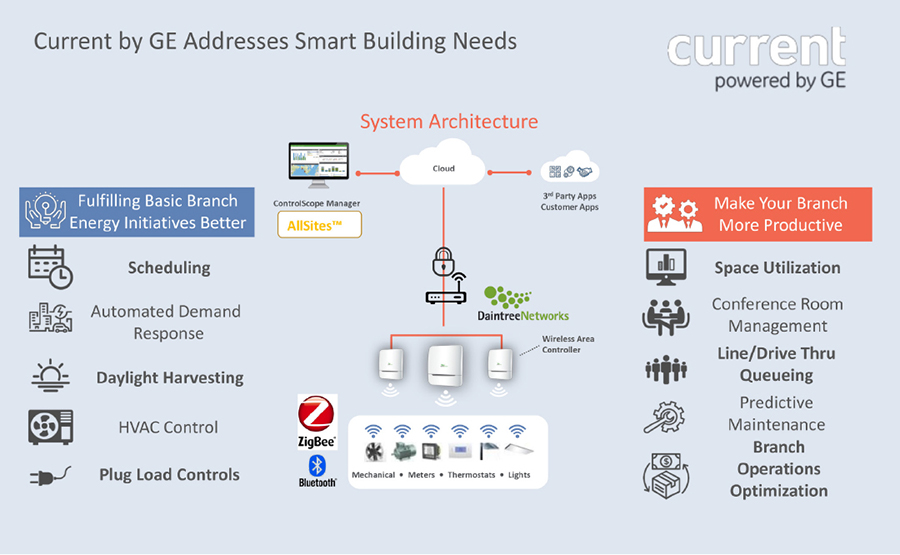
Combining standards-based edge lighting devices with native power metering, HVAC devices, control applications and sensor analytics is not possible with any of the other solution platforms today. This functionality and the hundreds of devices used in these applications are enabled by the ZigBee standard.
Investment and Economic Outcomes
Current’s value proposition can be applied to individual branches as well as the entire portfolio. We previously outlined that our solution’s impact on 100 sites is close to $1 million per year. We can break that down into a more granular look at how a single branch is affected.
The following retail branch model is based on a generalized bank branch. Current estimated the potential investment based on similar customers. We used the national average square footage (4,000 sq. ft.) and the national average energy rate, as well as the available energy usage data, to calculate savings. We have also incorporated the estimated tax incentive stemming from the installation.
The benefits of Current’s solution are extensive. Bank branches that upgrade to LED lighting experience up to 50 percent reduction in energy costs. The long lifespan of LED fixtures also leads to increased maintenance savings, bringing the total annual savings of each branch to more than $4,500. Adding lighting controls and edge sensors provides $1,800 in energy and maintenance savings, in addition to ancillary benefits. Branches will experience improved safety and security thanks to LED lighting and controls.
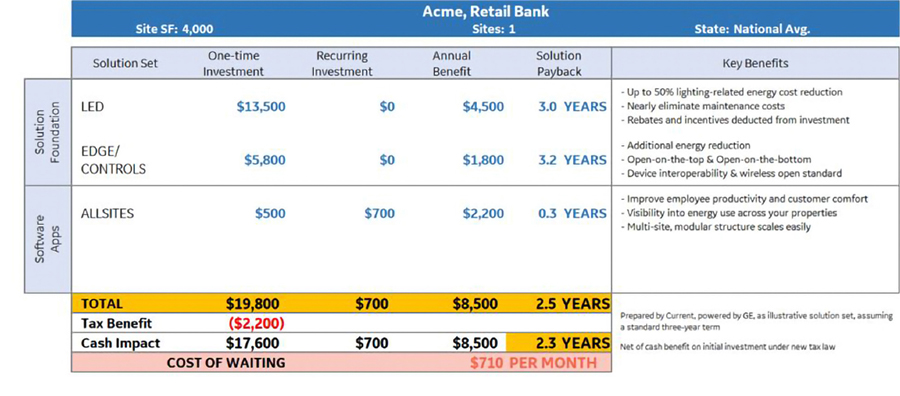
Multisite management is made easy with AllSites, which can magnify energy and maintenance savings thanks to its monitoring and alarming capabilities. With the help of the platform, facilities and maintenance teams are able to quickly identify poorly performing assets or malfunctioning units. The ongoing investment in this software platform results in an annual ROI of $2,200 for each bank branch. AllSites has an impressive solution payback period of just four months.
The ongoing investment in AllSites results in an annual ROI of $2,200 for each bank branch, with an impressive solution payback period of just four months.
Not only can teams receive alerts regarding locked doors or facility access, but they can also address ATM compliance issues with better lighting in vestibules or outdoor kiosks. AllSites is instrumental in managing those alarms and alerts. This does not include the value of using predictive maintenance to avoid downtime or branch closures that would otherwise negatively impact the customer experience. Upgrading all facilities cultivates a cohesive, standardized look across all branches and ensures this better aesthetic is present no matter where customers need to bank.
Overall, Current’s solutions provide an annual benefit of more than $8,000 per bank branch, and the average branch will break even after just 2.3 years.
Overall, Current’s solutions provide an annual benefit of more than $8,000 per bank branch, and the average branch will break even after just 2.3 years. Branches that are not updating effectively cost themselves close to $1,000 each month they postpone the inevitable change.
Execution and Efficiency in the Field
While Current provides a very diverse repertoire of solutions for smart buildings of the future, we also believe in leveraging experience in the field and have a large proven partner network to do so. A world-class partner network is essential for achieving success in the selection, procurement, installation and ongoing support of smart building technology. Current’s partners grow with us to bring the latest technology advances in intelligent environments to banks. Nobody provides all of the solutions required, no matter what the competition claims.
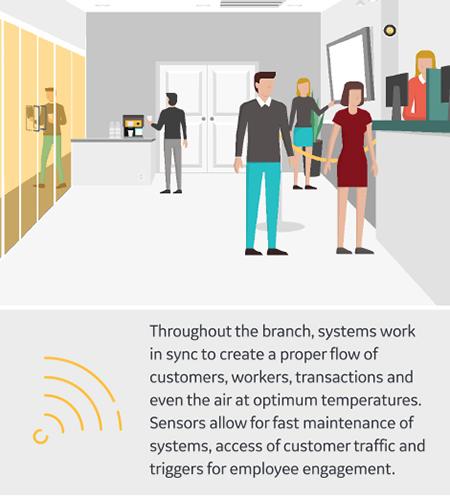 Because the sensor network infrastructure is truly the underlying platform for all smart buildings’ operational efficiency, it must be “open” and able to evolve with a building. The sensor network is to the building what the central nervous system is to the human body. The platform must be “open on the top” to continuously allow for the addition of new business productivity applications that need to leverage data to provide value. In addition, it must be “open on the bottom” to allow for ever-evolving sensor technology, regardless of vendor, to plug into the network and provide new information for future efficiency gains. Such an availability of big data, ever-advancing sensor technology and open APIs to access the data provides banks with endless potential to operate more efficiently.
Because the sensor network infrastructure is truly the underlying platform for all smart buildings’ operational efficiency, it must be “open” and able to evolve with a building. The sensor network is to the building what the central nervous system is to the human body. The platform must be “open on the top” to continuously allow for the addition of new business productivity applications that need to leverage data to provide value. In addition, it must be “open on the bottom” to allow for ever-evolving sensor technology, regardless of vendor, to plug into the network and provide new information for future efficiency gains. Such an availability of big data, ever-advancing sensor technology and open APIs to access the data provides banks with endless potential to operate more efficiently.
The Path Forward
This white paper was intended to provide an understanding of the available technology that will enable a bank branch to realize energy savings, manage its portfolio more efficiently and provide the framework to address future opportunities. Having delivered varied solutions to several national and regional financial institutions, we are confident that we can provide the highest-quality and most-diverse lighting solutions available, robust sensor technology and networks for operational efficiency, an open environment for future technology advances and a partner network to enable all aspects of such a prestigious undertaking to achieve success.
Understanding there are various ways to move forward with a program, starting with a pilot program would provide banks an understanding of the technology, how it would be delivered and the functionality of the systems.
- Current would identify 5-10 sites that best represent the overall portfolio and create Bills of Materials (BOMs) for each.
- Prior to installation, we would work to develop a list of clear success criteria that would be measured during this pilot phase to ensure all goals and objectives are met.
- With an established base of installers, we would collaborate with your team to determine a partner that best meets your needs. They would install and commission each branch.
- After installation, our teams would work together to review the outputs from the system and track that the success criteria are being met.
If you’re interested in learning more about what Current can do for financial institutions or if you would like to receive a personalized value proposition model to see exactly what you can save with an LED upgrade,
![]()
†Current with Intel technology, is transforming smart building management through an open, wireless control solution that maximizes the value of building assets, unlocks operational efficiencies, and digitalizes intelligent environments.
Intel and the Intel logo are trademarks of Intel Corporation in the U.S. and/or other countries.


